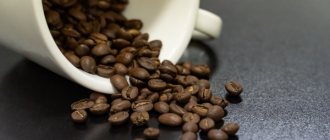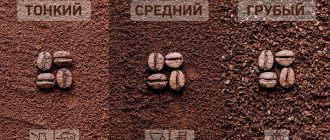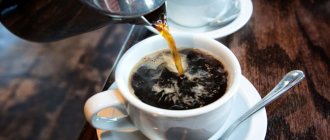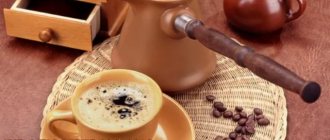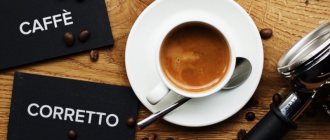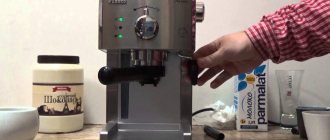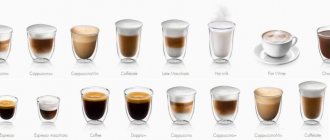Lungo or Americano
Often, society confuses these drinks due to the similarity in the composition of ingredients, as well as volume and appearance. However, their taste and character sometimes differ significantly from each other.
Let's look more specifically:
| Americano | Lungo |
| prepared by adding boiling water to a shot of espresso | the liquid involved in the preparation of the drink is passed through the coffee during the extraction process |
| comes out tender and not very rich in taste | brighter, stronger and more awakening than Americano, includes more bitterness in taste |
| V varies from 200 to 250ml | V varies from 90 to 180ml |
| little or no creamy foam | creamy foam dense, like espresso |
| the effect of vivacity is weak | There is more caffeine in the composition than in Americano, accordingly, it awakens better |
It is noticeable that these 2 drinks still have many differences. With this information, it will be easier for you not to confuse them.
Flavor differences and how to use them
As I mentioned earlier, espresso, ristretto and lungo are all variations of the same basic method of coffee preparation. The main differences are in the taste and concentration of caffeine.
Espresso Flavors
Espresso has the darker, earthier, and nuttier notes that are found in all coffees. In fact, some of the best cups of espresso I've ever had exhibited enough chocolate and cocoa flavors to only briefly convince me that I was drinking melted chocolate.
Cream, the brown-white foam that forms on the top of the espresso, is often one of the sought-after parts of espresso and the defining characteristic. This produces smooth chocolate, marzipan and creamy notes.
All this does not mean that espresso will not contain floral notes from the same coffee prepared in different ways. But these notes will appear differently against a more mundane background and the risk of drowning.
Ristretto Flavors
The strong earthy tones of the basic espresso method come from the extraction time and high pressure. Ristretto shares high pressure, but less water means shorter, less thorough extraction.
Consequently, we still get some earthy notes, but our crema will be thinner and the chocolate notes will generally be absent. Instead we get floral and aromatic coffee notes.
Expect strong herbal notes along with floral and dark fruits, especially
in the smell of the drink. On the tongue, expect the same, but with a strong emphasis on herbs and flowers instead of fruit.
Lungo fragrances
E the only ones
remaining aromas are roasted, smoky notes. The extraction here is so close to overdone that you might even believe your espresso has burnt due to the notes presented.
But that doesn't mean lungo doesn't have meaning and that you won't enjoy the flavors.
Differences from espresso
The main difference between the drinks in V. The serving of classic espresso is half that of lungo. By no means, this is not all that distinguishes them. The second product has more bitterness and is the most intense.
In terms of time, preparing an espresso lungo takes twice as long. It is not as useful as the “traditional” replacement. The reason is the almost complete evaporation of essential oils from coffee beans as a result of increasing the steaming period. In addition, due to the loss of important taste qualities from the raw material, the coffee comes out bitter.
What is Ristretto?
Ristretto is a variation of the espresso method. It's easy for me to remember "ristretto limit" because you limit
Approximately half the water supply when preparing the ristretto.
This water restriction means that less water saturates the coffee. This results in lower caffeine levels, which could be seen as a disadvantage, but more "aromatic" notes are present due to the short extraction time.
In fact, Ristretto focuses on the more "aromatic" aspects of the espresso preparation method. Less water flows through the grounds layer, but flows faster, leaving some of the more floral, higher notes of the coffee itself intact.
Ristretto shots are less common than espresso shots, simply due to their lower yield and lack of caffeine.
If one were to try to further understand the individual characteristics of coffee at all levels, ristretto would show more subtle notes that would not be present in longer, wetter extractions.
Thus, a typical American ristretto recipe is about 7 grams of coffee per 12.5-15 ml of water.
Important tips for drinking Lungo coffee
Residents of Italy are of the opinion that it is better to enjoy this drink in the morning. It is intended for people who are eager to wake up and get to work quickly.
- Use only freshly ground coffee beans. Volatile components instantly evaporate and, if in other manufacturing variations there is a chance to stock up for several days ahead, here it is necessary to grind a fresh amount from time to time.
- Choose your grains wisely; they should be free of bitterness and sour taste. Buy the most expensive and high-quality varieties.
- In the mix, use mainly Arabica - 80%, rather than Robusta - 20%, the product will be richer. This is a quality formula developed over time.
- Use a medium grind, in this case all the beneficial ingredients can be released into the water. With fine grinding, the taste will be burnt and bitter, with coarse grinding it will be unaromatic and sour.
- The increased caffeine content motivates mental work, so you can treat yourself to a portion of good Lungo, combining business with pleasure, planning to start working on an intellectual task.
For you:
Ristretto: sunny greetings from Italy
To achieve maximum taste of the drink, it is necessary to select only the best ingredients for preparing the drink. Eliminate liquids from the tap - give preference to bottled water. If you want to supplement the drink with milk, check its composition and date of manufacture.
Excursion into coffee
As a rule, when purchasing a coffee machine for private, household use, we have no idea what miracles it can work. Yes, of course, its direct purpose is espresso , but there are many coffee cocktails and drinks that professionals in bars, restaurants, and coffee shops delight us with. Imagine you have guests, and instead of the usual espresso , you prepare a chic latte with a fluffy milk cap, and sometimes it’s not a sin to treat yourself to a fragrant cappuccino with a croissant. So your little (unlike the huge restaurant equipment) home “friend” can do it all. All you need is a little skill, skill and knowledge of the recipe. Of course, you won’t be able to serve coffee cocktails to a party of fifty people at a time (you wouldn’t be playing tricks on the machine all evening?!). Let's not forget that you still have a household unit, and not a professional coffee machine, but you will be able to surprise the inexperienced. So, a short excursion.
Espresso ? This is strong black coffee brewed in a coffee machine. Translated from Italian, “espresso” means “fast”? and indeed, this coffee is prepared, served and drunk very quickly. Although there is another interpretation of the word “espresso”? it is translated as “compressed” or “pressure welded”. This drink originated in Italy at the beginning of the 20th century, and since then Italian espresso has come to be considered the standard of coffee quality throughout the world.
Espresso ? a kind of “king” among coffee. It is on its basis that all other coffee drinks are created, and it is on its quality that the quality of these drinks depends.
Preparing espresso :
To prepare one serving of the drink, 7 g of ground coffee and 40 ml of hot water (t? ? 88? 96 ? C), supplied under a pressure of 9 atmospheres, are required. The coffee extraction time in the coffee machine is 25 seconds (+/- 3 seconds). During this time, a standard espresso cup should fill to the top of the handle.
The quality of the resulting espresso is influenced by the following factors:
* Freshness of beans
*Freshness and grind size
* Water temperature and pressure in the coffee machine
* Daily care of the coffee machine
The ideal espresso is determined by the foam (do experts call this foam the Italian word for cream?). The foam should be homogeneous, even, dense and have a beautiful, golden-walnut hue. Depending on the composition of the coffee mixture (ratio of Arabica and Robusta), the color of the cream? may vary. Thickness of the cream? must be at least 2 mm.
High-quality espresso has the aroma of freshly ground beans. The basis of its taste is a pleasant balance of sourness and bitterness; it has a feeling of freshness and completeness of taste.
Espresso is consumed “live”, i.e. during the first 1–1.5 minutes after cooking.
If you increase the coffee extraction time by just 5-10 seconds, you get a classic Italian drink called espresso lungo (“long espresso”). The volume of a lungo espresso serving is 50–60 ml. This drink is stronger than espresso (due to its higher caffeine content), but has a less rich (more diluted) taste.
Cappuccino is the second most popular coffee drink in the world and is a mixture of espresso and steamed milk. The drink received this name due to its color, reminiscent of the color of the hoods of the Capuchin monks. It is generally accepted that it was the Capuchins who were the first to come up with the idea of adding frothed milk to coffee. Capuchin monks noticed that when pouring milk foam, beautiful patterns could form on the surface of the drink.
To prepare a cappuccino , a shot of espresso is mixed with milk and milk foam in a one-to-one ratio (40 ml espresso, 40 ml milk and 40 ml milk foam). It is better to use milk with a fat content of 3.2–3.5%. First the milk is frothed and then the espresso is brewed.
Milk foam is formed by heating milk and saturating it with air bubbles, while the milk itself approximately doubles in volume and acquires a pleasant sweetish-creamy taste. In a coffee machine, milk is frothed using a steam tap, also called a cappuccino maker.
You can check whether the cappuccino is prepared correctly by placing granulated sugar on top of the foam on the cup: if the foam is well whipped, the sugar should remain on the surface. In addition, within about a minute, the foam can be “raked” with a coffee spoon without finding the coffee itself in the cup. When serving cappuccino to a guest, the temperature should be 60–70 degrees.
Latte.
Translated from Italian, the word “latte” means “milk” (it is considered correct to emphasize the first syllable). In coffee terminology, this word refers to a layered cocktail consisting of espresso, milk and a small amount of milk foam. One part espresso (or any other strong coffee, but not Americano) requires three parts frothed milk.
Making a latte :
espresso is slowly poured into it in a thin stream . If this procedure is performed carefully, the layers of coffee and milk will not mix, resulting in a delicious layered coffee cocktail, which is sometimes also called a latte macchiato.
Latte foam should be fluffier and airier than cappuccino foam. Its texture is similar to shaving foam.
Latte is served in an Irish glass, in a special large cup or in a tall glass with a straw. You can add any syrups intended for making coffee cocktails to the drink (except citrus, as it turns the milk sour). The combination of latte coffee and blackcurrant syrup is considered the most successful.
There are many layered latte-based coffee cocktails: cinnamon latte, pecan latte, iced latte, ice cream latte, chocolate whipped cream latte. You can even make an alcoholic cocktail - for example, an amaretto latte or a rum latte.
Italians prefer to drink lattes in the morning, just like other coffee drinks with milk. Surprisingly, in Italy itself, the Italian latte is less popular than in other European countries - Italians love strong black coffee too much.
Ristretto ? This is the most concentrated, strongest and most invigorating coffee, brewed in a smaller volume than espresso (7 g of coffee per 20-25 ml of water). To prepare it, ground coffee is well pressed and extracted under a pressure of 9 bar for 15 seconds.
Many people think that ristretto contains too much caffeine, but this is not true. In fact, in the first 15 seconds of coffee extraction, coffee essential oils enter the ristretto Therefore, a shot of ristretto contains even less caffeine than a shot of espresso.
Ristretto has become very popular in Italy; it is deservedly considered the “most Italian” coffee. From Italian “ristretto” translates as “strong”, this coffee instantly gives a powerful boost of energy. A serving of this aromatic drink with thick cream? and rich, concentrated flavor takes up about half a standard cup of espresso. It is designed for literally 1-2 sips, so Italians usually drink ristretto without leaving the bar. Adding sugar to ristretto is considered bad manners.
The drink is usually served in an espresso cup (or a special miniature cup without handles) along with a glass of cold drinking water. Usually, before the first sip of ristretto , take a few sips of water. Water prevents dehydration and also cleanses the taste buds and allows you to enjoy every sip as if it were new.
Coffee "Americano
Americano (American coffee, regular coffee) got its name because it was widely popular in North America.
Americano coffee appeared thanks to the Americans' craving for a healthy lifestyle: it is believed to be healthier because it contains less caffeine. In fact, this statement is not entirely true.
There are two types of Americano: actual American coffee, which is prepared in a filter coffee maker (volume 220 ml, temperature 85? C) and Europeanized Americano, or espresso with the addition of boiling water (volume 120 ml, temperature 84-92? C). In the first case, the caffeine content in a cup of Americano will be significantly higher than in a standard shot of espresso. In the second case, it will be the same, but the concentration of caffeine will decrease significantly.
And yet the desire to lead a healthy lifestyle? This is by no means the only reason to love Americano coffee. Many people simply like its taste and the fact that it is less strong, rich and concentrated than classic espresso. It is impossible to brew weak coffee in an espresso machine, and the only way to get something resembling American filter coffee is to dilute the espresso with water.
There are two ways to prepare Europeanized American-Italian and Swedish.
Methods for preparing Americano :
The Italian method is to dilute the finished espresso with hot water. In this case, the foam on the surface of the drink is completely destroyed. Since classic filter coffee does not have foam, is there cream? Americano (diluted espresso) is also not considered mandatory.
The Swedish method of preparing Americano differs from the Italian one in that boiling water is first poured into the cup, and then espresso is added.
You can place a cup of hot water directly under the coffee dispenser and brew espresso into it. In this case, delicious cream? will remain, but will become lighter and less persistent. In all other respects, “Swedish Americano” is no different from Italian, although coffee connoisseurs believe that the first sip of this drink has a softer and richer taste (due to the foam).
Classic coffee cocktails
Espresso conpanna comes in a single shot and has a fluffy top of whipped cream. Translated from Italian, “con panna” means “with cream.” The espresso first sprinkled with ground cinnamon, then whipped cream is placed on top and sprinkled with more cinnamon.
Viennese coffee is prepared as follows: put 1-2 small pieces of dark chocolate in a cup, then brew lungo espresso and mix it with melted chocolate. The drink is topped with whipped cream and grated chocolate.
Borgia coffee ? This is a traditional Italian coffee cocktail. Pour 20-25 ml of chocolate syrup into the bottom of the cup, then brew espresso lungo and mix the coffee with the syrup, adding a few strips of orange zest. The drink is topped with whipped cream and orange zest. You can use hot chocolate instead of chocolate syrup.
Coffee Glace ? This is a cool coffee cocktail dessert with ice cream. Double espresso is best for making glace , but you can also use Americano . Place a scoop of creamy ice cream (50 g) into the finished coffee and sprinkle the resulting cocktail with grated chocolate. You can add chocolate syrup and whipped cream if desired.
Non-alcoholic coffee cocktails
Coffee "Shirley"
Pour 5 ml of vanilla and 5 ml of chocolate syrup into a cup, then pour in the espresso lungo until about 1.5 cm remains to the edge. Add ground cinnamon and stir. Top with whipped cream and sprinkle with chocolate.
Coffee cocktail "Liegeois"
Beat the egg yolk and add sugar to taste. Mix the resulting creamy mixture with espresso and garnish with whipped cream. It is customary to drink the cocktail with a piece of Belgian chocolate.
Coffee cocktail “Italian breakfast”
To make this cocktail, you will need Italian zabaione sauce, consisting of egg yolks, caramel and Marsala wine. Mix the sauce with freshly brewed espresso , garnish with whipped cream and sprinkle sesame seeds on top.
Coffee cocktail with cinnamon
Brew a shot of espresso and add 30 ml of cinnamon syrup to it
and a small amount of 11% cream. Steam the resulting mixture, pour into a glass and garnish with a cinnamon stick.
Latte “Baklava”
Add 15 ml of nut syrup to the milk and whisk it with steam. Carefully pour 20 g of melted honey into the resulting foam, and then? shot of espresso. Garnish the drink with ground cinnamon and grated nuts.
Iceland coffee cocktail
Whisk milk with barley syrup (10 ml), add 40 ml of chocolate sauce to the resulting foam so that the sauce lies at the bottom of the glass. Then carefully, in a thin stream, begin to pour in the espresso. The result should be a black and white cocktail with layers of hot milk, chocolate and classic Italian espresso .
Irish Frappuccino
Make a double ristretto and mix it with 100ml fresh milk and 20ml Irish syrup. Shake the resulting mixture with ice, pour into an Irish glass and garnish with whipped cream.
Cocktail Black & White
Pour 40 ml of melted white chocolate into a glass (you can replace it with white chocolate flavored sauce). Then add 40ml of hot dark chocolate, steamed milk and a shot of espresso . The result should be a “striped” cocktail with layers of dark and white chocolate, a black layer of espresso and a white layer of milk foam.
Mocha
Prepared in much the same way as a latte. This drink traditionally contains espresso , hot chocolate (or chocolate syrup), whole milk and whipped cream. Chocolate chips are sprinkled on top of the drink. Mocha is served in an Irish glass or a tall glass.
Coffee connoisseurs are constantly arguing about this cocktail: is it really Mocha? it is a port in Yemen after which a type of Yemeni coffee is named. To avoid any confusion, we recommend that you come up with your own name for the coffee drink with milk, chocolate and whipped cream.
Coffee cocktails with alcohol
Coffee "Amaretto"
Pour 45 ml of Amaretto liqueur into a glass. Add freshly brewed espresso and top with whipped cream and cherries.
Viennese cocktail
Prepare a serving of classic cappuccino . Add 30 ml of Sambuca liqueur to it, sprinkle ground cinnamon and grated orange zest on top. You can use grated chocolate instead of cinnamon.
Irish coffee
Pour a standard portion of Irish whiskey into a warmed tall glass, add a teaspoon of sugar and a shot of espresso . Top the drink with a small amount of whipped cream (heaped dessert spoon).
Amaretto coffee with sambuca
Mix 20 ml of Amaretto liqueur and 20 ml of Sambuca liqueur, pour espresso and top with whipped cream.
Amaretto coffee with ice cream
Mix 20 ml of Amaretto liqueur with a shot of espresso . Place on top
scoop (50 g) of coffee ice cream and garnish the drink with a coriander seed.
Amaretto coffee with rum
Mix 15 ml of Amaretto liqueur and 15 ml of dark rum, add espresso , top with whipped cream.
Coffee "Galliano"
Mix fresh cream with 45 ml of Galliano liqueur and beat with a mixer until a dense foam forms. Pour a shot of espresso into an Irish glass, top with whipped cream and garnish with a cherry.
Swiss coffee
Mix 45 ml of dark liqueur Creme de Cacao with 20 ml of Peppermint liqueur and add a shot of espresso . Top with whipped cream and garnish with a cherry.
Coffee cocktail "Pucci"
Heat 20 ml of Amaretto liqueur and 20 ml of brown rum in a glass. Pour a shot of espresso and add 2 pieces of refined sugar, then stir. Lightly whisk the cream (so that it remains liquid) and carefully pour it in a thin stream into the cocktail glass.
Al Strega coffee cocktail
Pour 30 ml of Strega liqueur espresso Decorate a glass with a drink with a twist (long spiral
from orange or lemon zest).
Coffee "Mazagran"
Place ice cubes in the bottom of the glass, then pour in a shot of espresso .
Add a few drops of cherry liqueur to flavor the drink.
I sincerely hope that you find this coffee map useful.
I wish you good luck in acquiring your barista skills!
PS: Dear readers! Especially for you, another recipe based on ristretto . It is unlikely that you will find it anywhere, but it is very invigorating in the morning.
Coffee capa
Place 5 grams of sugar in a tequia glass, fill 2/3 of the cream with 33% and very carefully add a portion of ristretto. They drink in one gulp.
Try it and look forward to your comments on the forum.
Useful and harmful properties of Lungo
True Italians consume Lungo only once a day and exclusively before 11:00 in the morning. The drink wakes you up and relieves drowsiness, but if you take it at later hours, you can get signs of increased overexcitation, nervousness, and even give yourself a sleepless night.
However, even if you are in good health, you should not get carried away with this product on a daily basis, but rather limit yourself to taking it 4 to 5 times a week. A person with signs of cardiovascular disease should completely avoid taking this type of coffee, switching to analogues with the lowest caffeine concentration.
Traditional recipe
To make the traditional Lungo recipe there is only one option. The raw material is based on 7 to 10 gm of freshly ground medium-ground coffee beans, ideally a mix of Arabica and Robusta. A coffee capsule is made from this mixture, attached to the group of the espresso machine, and then the liquid is started to flow for 60 seconds.
Under the hot stream, you should first place a heated “demitasse” - a bowl made of ceramic with compacted walls, V from 70 to 90 ml. This will allow a dense foam to form and prolong the temperature of the coffee.
In everyday life, it is possible to brew Lungo espresso using a capsule-type coffee machine. Under such conditions, to prepare a tonic drink, a simple espresso capsule and twice the period of pouring liquid through it will suffice.
What other Lungo coffee recipes are there?
Cold chocolate Lungo
Made according to the real recipe with the addition of a spoon of granulated sugar, coffee V 100 ml is poured into a large glass, into which 2 pieces of ice are thrown.
For you:
Ice Latte is the best refreshing solution on hot days
This Lungo is topped with whipped cream and sprinkled with grated chocolate chips. A great option to get a boost of energy on a hot summer day.
Coffee classics from Australia
During one of the championships, barista Matt Perger presented his personal creation - the Australian Lungo. To make it, you will need to use lightly roasted and extremely finely ground beans. During the preparation process, the drink is brewed in an espresso machine for 25-30 seconds.
Due to the fine grind, particles of ground beans can get into the cup, so it is very important to eventually filter the coffee to get rid of the excess.
The result is a high-quality, rich drink, endowed with an exquisite aroma and bright taste. Matt recommends consuming this masterpiece slightly cooled; at this temperature, it perfectly reveals its taste.
Ristretto coffee recipes
The “one-sip drink,” which is brewed in a minimal amount of water, comes in different variations. The main conditions are that it is prepared in a coffee machine from dark or medium roast beans. Arabica is suitable for medium grinding, and Robusta - fine. Sometimes both types are mixed to create a bright bouquet. The horn of the coffee maker should be wiped dry to prevent drops of moisture from getting into it.
Ristretto, the recipe for which includes ingredients such as freshly ground roasted coffee beans (8 grams), drinking water (15-20 milliliters) and granulated sugar to taste (you can do without it), is cooked for 15 seconds.
In the coffee machine
The beans are ground evenly, poured into a dry coffee maker, carefully compacted with a templer for uniformity. To reach the required temperature, pour boiling water into the cup through the coffee for a couple of seconds (this is the soaking function, without which it will not “open up” and give off its aroma), and then turn on the water for 3 seconds. Then extraction occurs for 15 seconds, resulting in a drink according to the original Italian recipe.
Classic recipe
Place a cup on the stand of the coffee machine, pour the ground powder into the holder (10 grams) using a measuring spoon, place it in the machine, pour water into a special container and turn on the desired mode. As soon as there are 15-20 milliliters of drink in the vessel, the machine turns off.
The classic recipe is the basis for cappuccino, latte, and iced glass.
Chocolate
It will require:
- finely ground coffee – 9 grams;
- water – 25 milliliters;
- milk – 25 milliliters;
- 2-3 pieces of dark chocolate;
- a teaspoon of chocolate sauce;
- whipped cream to taste.
Brew regular coffee in a coffee machine and pour it into a large container. Crush dark chocolate into the milk and place it in a water bath so that it dissolves in the milk. The chocolate-milk mixture is poured into coffee and decorated with cream.
Russian
Russians are used to sipping coffee slowly, in a warm, friendly company, in a romantic atmosphere, so cappuccino and latte are more familiar to them. Despite the fact that ristretto is unknown to wide circles in Russia, there is a “Russian” version of it among Italian drinks. It is often served to our tourists.
To prepare it, take 7-9 grams of coffee and 30 milliliters of water. The result is a 15-second decaffeinated nectar.
Serving and consumption
A professionally prepared drink, brewed in a coffee machine, flows straight into a heated cup with a volume of 60 to 90 ml. Serving takes place in it, in combination with a saucer and spoon. As a dessert, almond cookies or oriental sweets are suitable for Lungo.
In Lungo coffee, compared to espresso, it is customary to add a small amount of sugar or honey to soften the bitter taste. In addition, it is customary to serve a glass of pre-chilled still water with coffee.
What is lungo served in?
The finished coffee can be served in espresso cups with a volume of at least 120 ml.
Traditionally, containers for espresso-based recipes have thick walls to prevent the liquid from cooling too quickly. On sale you can find lungo cups with a volume from 170 to 280 ml. They are filled half or a third with the drink and retain the temperature of the finished coffee longer.
Summarize
Lungo coffee is the result of one of the methods of brewing coffee, differing from espresso in the highest caffeine content and unusual taste in the form of a slight bitterness. What are the features of this coffee?
During production, the number of coffee beans that is simple for espresso is used, but the dose passed through the liquid capsule is twice as large.
Espresso is endowed with a great aroma, but tones less, and when diluted with water it transforms into Americano without losing its qualities.
Traditional Lungo can only be prepared in a coffee machine, but there are a number of other ways to brew it, which in terms of taste and invigorating properties will be very similar to the original version.
Cooking technology
Translated from Italian, “espresso” also means “compressed.” When it is prepared, hot water is pressurized through compacted coffee powder.
Choosing a coffee maker
Real espresso is prepared only in a device that creates a pressure of 9 bar or higher. Semi-automatic and automatic coffee machines ideally meet this requirement. They also provide optimal heating of water to 86-92 °C for an invigorating drink. Hotter water will give a burnt taste, colder water will not brew coffee.
A metal holder is preferable, since plastic ones smell when heated. You can make espresso coffee at home without a coffee machine if you have a high-quality carob coffee maker.
- Don't miss: Which carob coffee maker to choose for your home
Coffee selection
Espresso blends often consist of Arabica and Robusta beans in percentage ratios of 80% and 20%. Arabica gives the drink a characteristic bouquet, and robusta gives strength and density. The beans should be medium or dark roasted. Shelf life is of great importance: old coffee will not have a rich bouquet, the required density and foam. A month after roasting, the beans are no longer suitable.
Flavored beans are not suitable: essential oils settle on the internal parts of the coffee machine and can harm its operation.
Fine espresso grind is used. It is a little coarser than for a Turkish coffee maker, but finer than for a geyser coffee maker. A finer fraction will give extra bitterness or clog the coffee maker filter, and a larger fraction will not give the desired aroma and density to the drink. The optimal size is fine salt.
